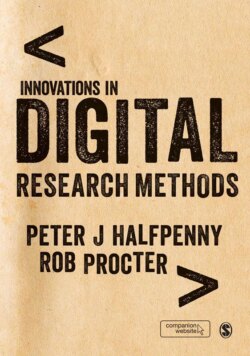Читать книгу Innovations in Digital Research Methods - Группа авторов - Страница 57
На сайте Литреса книга снята с продажи.
2.4.4 Competing Narratives
ОглавлениеThe new types of data reflect the new reality of the information society and that we are all living interlinked real and virtual lives. The emergence of new data types provides opportunities for new insights and new understandings of what might otherwise be intractable social problems. This can be seen as an opportunity but also a challenge.
Social scientists may face increasing competition to have their findings heard. For example, findings from surveys of public attitudes on particular issues are now competing with the reports of Twitter or blog postings. Each data type has its strengths and weaknesses. However, analysis based on social media data may be produced more rapidly and secure higher profile media coverage than more conventional social science research (with its often lengthy process of design, data collection, preparation, analysis and peer review).
Arguably, social scientists have always been in competition with alternative sources of information about, and explanations of, social phenomena. This includes journalists, and politicians as well as government department reports. A concern here is the robustness of the evidence base that is being used to inform the claims: it can be based on biased samples, small case studies or personal anecdotes. This might reflect the difference between what a representative survey suggests about what a particular population thinks and ‘what a taxi driver thinks’ (not an uncommon comment by policy makers) or even what people say to a taxi driver.74
The new aspect of this is the scale of the ‘what the taxi driver thinks’ data now that this can be promulgated through millions of Twitter postings. Where access to social media data is restricted then this denies social science researchers the opportunity to use the data and test the generalizability of findings based on selected posts. Ideally, the data would be available to be used for social science research alongside and in combination with traditional data types. In social sciences, issues of transparency and open data are paramount.
News and media outlets now commonly refer to tweets to exemplify certain opinions or views on an issue. Though this falls a long way short of claiming inference to a population, this is not always made clear. There is a link here to good practices established for journalists when reporting social survey data and the need to include sample size numbers and response rates.75 As yet, such guidelines are not widely available in relation to the use of social media data.76 A key principle (which could be at risk in the trend towards data journalism and the pressure for instant analysis and commentary) is that reported results should fairly reflect the data collected.77 Implementing good practice regarding access and use of new sources of data would imply redesigning data management processes, including the development of reliable methods for coding highly unstructured data.78 Similarly, new research design and analysis methods will need to be developed and, where the research design requires it, researchers might draw on statistical analysis techniques for non-probability samples, including Bayesian analytical techniques.
Where the data about a population of interest are complete (Mayer-Schönberger and Cukier, 2013), then there is no need for methods based on sampling and inference. However, even in the future this is likely to be limited to certain areas of research. As such, it is important to link our thinking here to well-developed standards in social science research concerning: hypothesis testing, objectivity, metadata, archiving and replication; see Bryman (1998; 2013) for a good overview. To get robust and reliable use out of the new data we need to apply the same principles of rigour as we would to more traditional and established types of data sources: objective research design, data collection, analysis and reporting.
Despite our concerns here, it is clear that the new types of data provide a genuine opportunity for alternative narratives and perspectives to emerge in social science from the changing data environment, as evidence gaps are filled and new evidence is exploited.
